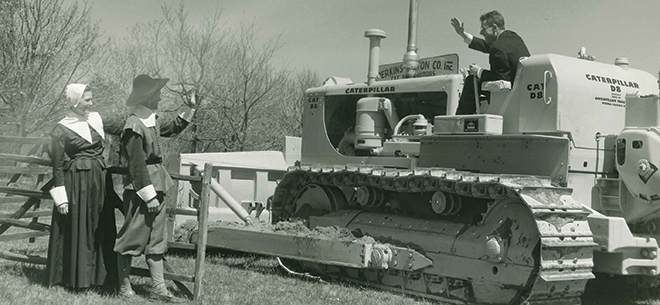The living history museum Plimoth Plantation, due to its connection to Thanksgiving, is a particularly poignant destination this time of year

The living history museum Plimoth Plantation, due to its connection to Thanksgiving, is a particularly poignant destination this time of year. A popular stop for aficionados of colonial history, this recreation of the early 17th century English settlement in Plymouth, Mass. seems as if it has been there for ages, yet its journey to existence is very much a tale of the mid-20th century.
The brainchild of Henry Hornblower II (1917–1985), the scion of a prominent Boston family, Plimoth Plantation was the end result of a combination of Hornblower’s interest in American history and archaeology and the many seasons he spent as a child visiting his family’s summer home in Plymouth. Hornblower, fascinated with the Pilgrims’ remarkable survival story and influenced by other historical recreations like Salem’s Pioneer Village, finally realized his vision of opening Plimoth Plantation—spelled in an archaic manner to distinguish it from the actual town of Plymouth—in 1949. In its earliest days, the nascent facility merely consisted of two cottages and a fort/meetinghouse near Plymouth Rock, yet grew by leaps and bounds over the subsequent decades. The most prominent addition was the English Village—where visitors encounter period-costumed interpreters who play the roles of various colonists—built on Hornblower family land along the Eel River about three miles from where the Pilgrims first settled. One of the original edifices still stands in place near the waterfront, but the fort was moved to the Village site, which essentially replaced the older constructs when it opened in 1958. Subsequent developments include the Wampanoag Homesite, added in 1973 to represent how the indigenous people of southeastern Massachusetts and eastern Rhode Island lived in the 17th century; the Hornblower Visitor Center, which was completed in 1987 and features a cafe and gift shop; a craft center (1992); Nye Barn (1995), which houses all kinds of heritage livestock; and a grist mill (2013).
One of the more famed highlights that has been absent the past few years is the Mayflower II, a replica of the original ship that carried the Pilgrims across the Atlantic Ocean in 1620. Crafted in England and given to Plimoth Plantation in recognition of U.S. and British cooperation during World War II in 1957, the vessel has been in Mystic, Conn. undergoing extensive renovations and is set to return in 2020, just in time for Plymouth’s 400th anniversary celebration.
Speaking of celebrations, any fan of Thanksgiving and this country’s past would be remiss in overlooking the annual commemoration held at Plimoth Plantation. The site of a 1621 harvest feast that is regarded as the main inspiration for our current turkey-centric holiday, Plymouth has a long relationship with Thanksgiving, and Plimoth Plantation marks this on November 28 with a homestyle buffet as well as the seated “The Story of Thanksgiving” dinners on November 28 & 29, which sell out quickly—make your plans now for 2020!


